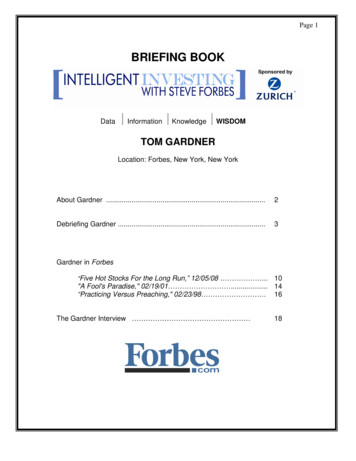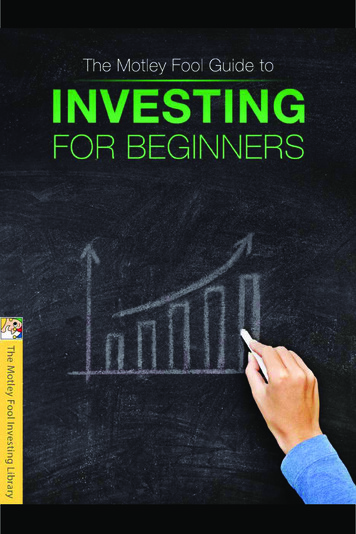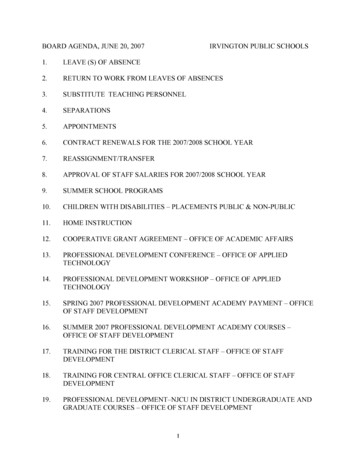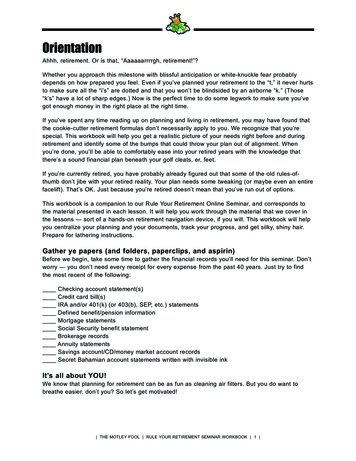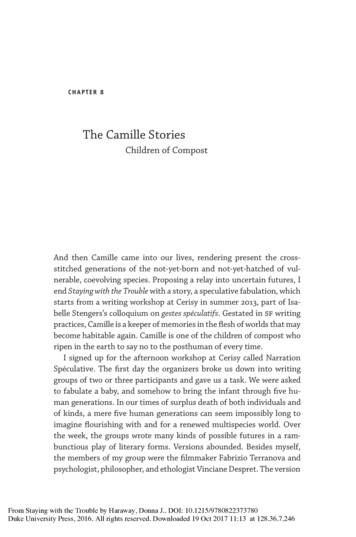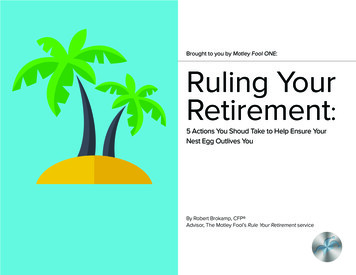
Transcription
Brought to you by Motley Fool ONE:Ruling YourRetirement:5 Actions You Shoud Take to Help Ensure YourNest Egg Outlives YouBy Robert Brokamp, CFP Advisor, The Motley Fool’s Rule Your Retirement service
FROM THE DESK OF TOM GARDNERDear fellow Fool,It’s pretty ironic when you think about it Being able to afford a comfortable retirement is the No. 1 goalfor the great majority of investors out there Yet for so many of them, it’s also the one financial topic theyknow the least about, and the one they spend the least amountof time focusing on.I’ll admit, I definitely fall into this camp, as well.Which is why I was so pleased when he agreed to take sometime out of his hectic schedule to put together an in-depthretirement report (which you’ll find directly below) and hosta follow-up retirement-focused conference call as part of ourongoing “7 Steps to Everlasting Wealth Challenge.”Of course, some of that has to do with the fact that, as I’ve oftensaid, I love what I’m doing here at The Motley Fool so muchthat I plan to never retire.Robert (or simply “Bro,” as we call him around here) is famous inour community for always going above and beyond on behalfof members like you, so I guess I shouldn’t have been surprisedby how comprehensive the report he put together actually is.But some of it also has to do with the fact that I devote so muchof my time to finding the best way to help Fools like you growand protect their nest eggs that there isn’t much time left overto think about how to best use those savings.But I’ll admit, after reading through it, I was absolutely blownaway both by how much thought and effort he put into it andhow valuable I found it to be (not to mention how much of thiscrucial information I didn’t already know!).Luckily for me (and the more than 300 Fools who work alongside me here), we have access to what I consider to be the ultimate retirement resource anytime we have a quick question orcomplex concern about our own retirement or the retirementsof our loved ones.So I hope you (and any loved ones you might want to pass italong to) will find it equally as valuable (That last point is especially comforting. After all, who doesn’tworry about whether aging family members are making all theright financial moves in retirement?)2But I realize that our members do not enjoy similar hands-onaccess to my longtime friend and colleague Robert Brokamp,CFP, and his decades’ worth of expertise on all things retirement related.And I do hope you’ll also join us for the follow-up retirement-focused conference call Robert will be hosting this upcomingMonday, September 12. (Full details on how to participate canbe found be at the end of this report.)It will certainly be one of the most important and highly anticipated events we hold all year — and no matter how near or faryou are from retirement, it’s one you definitely won’t want tomiss!
To doing everything we can to help you rule your retirement,Tom GardnerCo-founder and CEOThe Motley FoolP.S. — If, like me, after reading it you find yourself realizing justhow much help you actually need “ruling your retirement,” I’dencourage you to give some real thought to joining me in Motley Fool ONE when we officially reopen to new members forthe first and only time this year next Thursday, September 15.That way, you’ll have access to absolutely everything we haveto offer here at the Fool including all of the stock-focusedadvice that can help you grow and protect your wealth, as wellas Robert Brokamp and all of his retirement-focused resourcesthat can help you decide the best way to use those savingswhen the time comes.I can’t think of a more powerful one-two punch in the entireinvestment industry, so I do hope you’ll give membership in thispremier, all-access service your careful consideration!3
The goal of retirement is to make sure your money lasts longer than you do, and to have plenty of fun along the way. Althoughwe won’t tell you how to have fun, we will tell you about the five steps you should take to create a retirement plan that willendure for decades while still paying the bills.1. Take Out the Right AmountDetermining how much you can spend in retirement isn’t exactlyrocket science, but the two activities do have something incommon.It all starts with Bill Bengen, a fellow born in Brooklyn in 1947 whowent on to earn an aeronautical engineering degree from MIT. In1973, he co-authored Topics in Advanced Model Rocketry. But hebecame famous for another publication: “Determining WithdrawalRates Using Historical Data,” a 10-page study published in theJournal of Financial Planning in October 1994.Thus, the 4% safe withdrawal rate (SWR) was born.4Despite his degree and aspirations, Bengen didn’t become anastronaut. He instead began his professional career working inhis family’s soft-drink bottling company on Long Island, eventuallybecoming president and COO. After the company was sold in 1987,he became a Certified Financial Planner professional and openedhis own practice.Flexing his mathematical muscles, he sliced and diced the investment returns from 1926 to 1991 to determine how much his clientscould spend in retirement. His conclusion:“Assuming a minimum requirement of 30 years of portfolio longevity, a first-year withdrawal of 4%, followed by inflation-adjustedwithdrawals in subsequent years, should be safe. In no past case
has it caused a portfolio to be exhausted before 33 years, and inmost cases it will lead to portfolio lives of 50 years or longer.”In subsequent studies, he proposed refinements that could support a safe withdrawal rate that, as he told me in a 2007 interview,“for most people . is somewhere between 4.5% to 5%.”How the Original SWR WorksNote that Bengen’s original framework does not mean that aretiree would take out 4% of the value of the portfolio each year.Rather, it’s 4% of the portfolio in the first year of retirement; thenthat dollar amount is adjusted for inflation annually. For this reason,some people refer to this as the 4% initial safe withdrawal rate,emphasizing that the 4% applies only to the first year.Here’s an illustration. Let’s say you have a portfolio worth 500,000 on the day you quit work. You would withdraw 4%, or 20,000. One year later, you would adjust that amount accordingto the inflation rate over the previous 12 months. If inflation were3%, you would then withdraw 20,600 at the beginning of thesecond year of your retirement.A year later, you adjust again for inflation. Assuming it was 2% thistime around, you’d withdraw 21,012 ( 20,600 increased by 2%) atthe beginning of your third year of retirement.This process continues for each year of retirement. Accordingto Bengen’s initial research, the 4% initial withdrawal rate wasdeemed “safe” because the portfolio could provide these annualinflation-adjusted distributions and still have money after 30 years.Put it all together, and a SWR aims to mitigate three risks:1. Market risk: The 4% withdrawal rate has survived the worstinvestment conditions of the past century, including the GreatDepression of the late 1920s and 1930s, as well as the crash ofthe “Nifty Fifty” large-cap stocks in the early 1970s.2. Longevity risk: According to the Social Security Administration,the average 65-year-old male will live to age 84.3, and the average 65-year-old woman will live to age 86.6. Approximately10% of 65-year-olds live to 95. So a withdrawal rate that hashistorically kept a portfolio afloat for 30 years is playing it prettysafe.3. Inflation risk: The 4% SWR would have allowed a retireeto adjust annual withdrawals in order to keep up with theConsumer Price Index and still not run out of money, evenduring the hyperinflation days of the 1970s and early ‘80s.So that’s how the basic version works. Rather simple, actually.However, real life isn’t so simple, which is why over the years manyexperts have proposed many other withdrawal rates.1. Broadening the portfolioBengen’s first study included just large-cap U.S. stocks andintermediate Treasuries. Subsequent studies (including some fromBengen himself) expanded the portfolio to other assets, includingsmall caps and international stocks. The consensus of this workindicates that broadening the portfolio adds about 0.5% to 1% tothe initial safe withdrawal rate.5
2. Adjusting withdrawals according toportfolio performance(i.e., income doesn’t drop too much during bear markets, and youcan’t go too crazy during bull markets). Here’s how he described itin the Journal of Financial Planning:Although the 4% SWR has survived the worst investment and inflation periods in the past, most historical 30-year periods could havesustained a much higher rate. As Bengen stated in a 2011 interviewwith Forbes, a 65-year-old who began with a 4.5% withdrawal ratewould have reached 95 with at least as much in his portfolio as hestarted with in 96% of the historical periods.1. Allow withdrawals to increase during a bull market, but to notmore than 25% above the real [i.e., inflation-adjusted] value ofthe first year’s withdrawal.In fact, according to financial-planning expert Michael Kitces, theaverage retiree would have more than quadruple the startingamount. According to Kitces’ running of the numbers, the averagesafe withdrawal rate over all 30-year periods since 1871 is about6%. For many periods, it was much higher.Another method was devised by Bob Clyatt, who retired in 2001 atthe age of 42 and wrote Work Less, Live More in 2006. His “95%rule” states that each year, a retiree can take out the greater ofThe upshot is that retirees might be able to spend more —andenrich heirs less — if they’re willing and able to adjust theirwithdrawals according to market conditions. They take more whenthe portfolio is up, and take less (or at least not adjust for inflation)when the portfolio is down.Several methodologies have emerged over the years for how toadjust withdrawals for portfolio performance. In 2001, Bengenproposed a formula that he calls his “floor and ceiling” approach62. Allow withdrawals to decline during a bear market, but notmore than 10% below the real value of the first year’s withdrawal.1. 4% of the portfolio’s value at the beginning of the year, or2. 95% of the previous year’s withdrawal.Essentially, this allows the retiree to take out more when the portfolio does well but also has the retiree cut back when the portfoliodeclines – but not cut back more than 5% from the previous year’sspending. As he told me in an interview from February of 2016,his “95%” rule has sustained him through the Great Recession.Adjusted for inflation, his portfolio is worth the same amount itwas in 2001, despite two bear markets and 15 years’ worth ofwithdrawals.
3. Accounting for the real-life spending ofretireesand an 18% chance for at least one member of a married couple.This might be playing it too safe and could result in retireesspending less than they perhaps could.Do retirees need their income to keep up with inflation everyyear? Perhaps not, according to the Consumer ExpenditureSurvey from the U.S. Bureau of Labor Statistics. Its data suggestthat households headed by someone age 75 and older spend25% less than households headed by someone between theages of 65 and 74.Keep in mind that for the traditional 4% safe withdrawal rate tofail, markets would need to be worse than anything we’ve seenin the past century and the retiree would have to live a longlife. Historically, the odds of both of these things happening atthe same time are very low. To use an example from “SpendingFlexibility and Safe Withdrawal Rates” by Michael Finke, WadePfau, and Duncan Williams, let’s say a married couple of two65-year-olds could chose a withdrawal rate that had a 90%success rate over 30 years. However, when a range of potentiallifespans gets factored in, the success rate jumps to 98.2%. Inother words, there’s a mere 1.8% chance of this couple experiencing significantly below-average markets and one memberliving to age 95.In a 2013 study called “Estimating the True Cost of Retirement,”Morningstar’s David Blanchett examined the data from theConsumer Expenditure Survey data as well as from the RANDHealth and Retirement Survey. He came to the following conclusion (note that “real” in financial terms means “inflation-adjusted”):While research on retirement spending commonlyassumes consumption increases annually by inflation(implying a real change of 0%), we do not witness thisrelationship within our dataset. We note that thereappears to be a “retirement spending smile” whereby theexpenditures actually decrease in real terms for retireesthroughout retirement and then increase toward the end.Overall, however, the real change in annual spendingthrough retirement is clearly negative.”If spending declines as we age, we won’t need to take out asmuch from our portfolios in future years. The implication is thatwe can either begin retirement with a higher initial withdrawalrate, or retire sooner because we don’t need as much saved up.4. Factoring in a range of longevitiesMost SWR studies assume that people will retire in their mid-60sand live until their mid-90s, even though current mortality tablesgive that just a 10% chance of happening for a single individualThus, some studies have used sophisticated statistical methodsto mix mortality volatility with investment volatility. Rather thanassuming an arbitrary 30-year retirement, these studies factor ina range of life expectancies for each subsequent year in retirement and incorporate that into the analysis.Fortunately, you don’t have to do all of the math on your own.David Blanchett has created a free spreadsheet (found at http://www.davidmblanchett.com/tools) that contains the formulas herecommends. Just input your particulars (keep your inputs in justthe yellow fields), and the results are calculated for you.One of those inputs will be your life expectancy, and the spreadsheet will calculate that for you, too. But don’t miss the importantfootnote: “Optimal default retirement period is life expectancy(50% probability) 2 years.” In other words, his researchindicates that the most “efficient” estimate of retirement lengthis two years above the average life expectancy of a person of acertain age and gender.7
5. Incorporating fees, taxes, andperformanceFinally, we come to some real-world wealth-eaters that manySWR studies ignore. Generally, the analyses are based on thehistorical returns of indexes such as the S&P 500 or projectedreturns for asset classes. Some (but not nearly all) reduce thereturns by, say, 0.2% a year to account for the costs of investingin an index fund. But very few incorporate the annual feescharged by actively managed mutual funds (from 0.5% to 1.25%)or financial advisors (0.5% to 2%).Then there’s the reality that many investments underperformindex funds because of costs or lack of skill. And let’s not forgetUncle Sam’s take, especially for investments outside tax-advantaged retirement accounts.Fortunately, a few studies have investigated the effect of thesevarious costs on a safe withdrawal rate. It varies, depending onthe types of accounts and whether the fees paid to professionalsresulted in above-average portfolio performance. But the combination of taxes and fees can knock 1% off a safe withdrawal rate.What’s your safe withdrawal rate?Although 4% is a good starting point, several factors couldwarrant a different safe withdrawal rate for you. You have significant other sources of income. The moreyou rely on your portfolio to cover your expenses, the moreyou need to play it safe. However, if you have other incomesources — such as a pension or Social Security — that canhelp cover your must-pay expenses, you’ll be able to nudgeup your withdrawal rate. That way, even if the market tumblesand your portfolio takes a big hit, your basic lifestyle won’t bethreatened. You think the market is overvalued. Recent research hasestablished a relationship between market valuation on theeve of retirement and the SWR over the next 30 years — thehigher the market’s price-to-earnings ratio (the so-called “P/E10” or “Shiller P/E”), the lower the SWR. The current P/E 10,which uses the average of the previous decade’s earnings(adjusted for inflation), indicates that the market is currentlyrichly valued. You retire earlier or later. You’ll need to adjust your SWR forthe assumed length of your retirement. Someone who retiresin her 50s should take out less; folks who retire in their 70scan withdraw more.8
We know that this can seem like complicated stuff. Fortunately,there are some free online tools to help you zero in on the rightsafe withdrawal rate for you.As you fiddle with these number-crunchers, you might getdifferent results. That’s usually because of different tools usingdifferent assumptions about inflation, life expectancy, portfolioallocation, and future returns. Do what you can to keep theassumptions consistent. FIREcalc.com (http://www.firecalc.com/): It ain’t pretty, andtakes a little work to figure it all out. But it allows for a gooddeal of customization, as explained on the main page (scrolldown to the section that begins with “Each tab will take youto.”) PortfolioVisualizer.com imulation): The Monte Carlo Simulation allowsyou to test withdrawal rates from portfolios you create. Youhave a choice of a few spending methodologies and can alsosee how life expectancy can affect an estimated SWR. The Variable Percentage Withdrawal spreadsheet (https://www.bogleheads.org/wiki/Variable percentage withdrawal):Created by the Bogleheads online community, this spreadsheet “adapts to the retiree’s retirement horizon, assetallocation, and portfolio returns.” Vanguard’s Withdrawal Rate Calculator ent/withdrawal-in-retirement-tool): Very easy to use, though it doesn’t allow for toomuch customization. The Simple Calculator (http://www.davidmblanchett.com/tools): Give David Blanchett’s spreadsheet a whirl.9
2. Make the Most of Your Retirement AccountsChances are, your investments are scattered across a few typesof accounts, including regular taxable brokerage accounts,traditional tax-deferred accounts, and maybe one or more taxfree Roths. If you indeed have contributed to one or more UncleSam-sanctioned retirement accounts, pat yourself on the back.They bestow some powerful tax benefits. A taxable, non-retirement account: The taxation of anaccount that isn’t an IRA or employer-sponsored retirementaccount [e.g., a 401(k)] varies. Interest from bonds and CDs aswell as short-term capital gains are taxed as ordinary income,but qualified stock dividends and long-term capital gains aretaxed at lower rates, currently between 0% and 20%.But if you’re not paying attention to the types of investments youput in these accounts, or the order in which you tap them in retirement, you might be missing out on opportunities to leveragethese accounts for even more tax savings — and increase thelongevity of your entire portfolio.Studies have shown that making the right choices about whichinvestments belong in which accounts can increase an investor’safter-tax wealth by 15% to 20% over a lifetime. So what are those“right choices”? They can be summed up by these five principles.First, let’s talk about which investments should go in whichaccounts — a concept known as “asset location.”Which eggs in which baskets?To understand asset location, you need to remember that mostinvestors have accounts that receive different tax treatment, suchas the following: A traditional tax-deferred account, like a traditional IRA ortraditional 401(k): Contributions may be tax-deductible, andthe investment growth and income aren’t taxed until moneyis withdrawn. Those withdrawals will be taxed as ordinaryincome — the highest tax rate most Americans pay. It rangesfrom 10% to 39.6%. A Roth IRA or 401(k): Contributions aren’t tax-deductible, butwithdrawals are tax-free if the owner follows the rules.101. Keep the most taxed investments intax-advantaged accountsStart by determining which of your investments or strategieswill generate the biggest tax bills (we provide some guidancelater on), and then make sure they’re relegated to your IRAs and401(k)s.2. Consider keeping bonds With tax advantages in taxable accountsSome bonds have their own built-in tax advantages. Treasuriesare exempt from state and local taxes, and municipal bondscan be exempt from all taxes — federal, state, and local. If youplace muni bonds in a traditional IRA, however, you lose the taxadvantages.
3. In taxable accounts, favor stocks with little to nodividends and those you’ll hold for many yearsLet’s say two investors invest 50,000 in the exact same stock and holdit for a decade. The stock doesn’t pay a dividend and earns an average of8% annually. Investor A holds the stock in his traditional IRA, and Investor Bholds it in her taxable brokerage account. A decade later, here’s the value ofeach account and the taxes each investor has paid through the years (at thispoint, they haven’t sold the stock yet):Investor AInvestor BHolds Stock In.Traditional IRATaxable brokerageaccountPre-tax Value of Account 107,946 107,946Total Taxes Paid 0 0Surprise! The values of the investments and the taxes paid (i.e., none) areexactly the same, even though Investor B held the stock in a “taxable”account. That’s because when you buy and hold stocks, especially ones thatpay little to no dividends, you have built-in tax deferral.But what happens when these investors sell their stocks to spend theproceeds in retirement? Assuming they’re both in the 25% tax bracket,Investor A will have to pay a 25% tax rate on everything he withdraws fromthe traditional IRA, whereas Investor B will pay just a 15% long-term capitalgains rate — and only on the profit. If they each liquidated the investmentand withdrew the cash from the accounts, here’s how much they’d have.Investor AInvestor BHolds Stock In.Traditional IRATaxable brokerageaccountPost-tax Value of Account 80,960 99,254Total Taxes Paid 26,987 8,69211
As if more after-tax wealth weren’t enough, there are otherbenefits to holding equities in your taxable account: If shares drop below what you paid for them, you can harvestthe losses by selling the shares and using the capital lossto reduce taxes. Of course, you can do that with any typeof investment, but stocks present more opportunities sincethey’re more volatile. If you hold dividend-paying foreign stocks in your taxableaccount, you can claim the foreign tax credit for any taxes assessed by the country in which your stock is headquartered.However, you can’t claim the credit if you hold the stock in anIRA or 401(k). Investments in a taxable account receive a stepped-up costbasis upon the owner’s death. Say a person buys stock for 10,000, and its value grows to 50,000. When he dies, thisperson bequeaths the stock to his daughter. Her new costbasis will be 50,000; she will not owe taxes on the 40,000of capital appreciation. A less fatal way to escape paying capital gains taxes is bydonating appreciated stock held in a taxable account to aqualified charity. Bonus: The donation can also be deductedon your tax return.While all these benefits sound good, the tax efficiency of holdingequities in a taxable account relies on your buying and holdingfor years and keeping dividends to a minimum. What do youdo for high-yielding stocks or those you trade more frequently?Read on, Fool.124. For your Roth, choose high-growth,tax-inefficient investmentsWhich account do you hope will be the biggest when you retire?The one with the best tax advantages, of course. That’s the Roth,since withdrawals are tax-free.Thus, the ideal investments for your Roth are those that havethe greatest return potential, especially if they’re tax-inefficient.Historically, small-cap value stocks have posted the highestreturns, and because of their generally higher turnover, themutual funds that invest in those types of stocks are among themost tax-inefficient — so these would be good candidates for aRoth. You could also use the account for any other active-tradingstrategies or real estate investment trusts, which pay a high yieldbut have dividends that aren’t eligible for the lower qualified-dividend tax rate.5. Retirement changes asset location a bitOnce you retire, if you plan to invest in high-yield stocks for theincome, it makes sense to hold them outside a tax-deferredaccount to take advantage of the lower tax rate on qualifieddividends. It’s less important where you hold the bonds thatproduce interest you plan on spending, since that interest will betaxed as ordinary income no matter what.
The hierarchy of tax inefficiencyHere’s a general order of investments, according to how much of your returnyou’ll have to give back when you file taxes. The order might be different foryou, depending on your specific investments. But this is a good starting point.1. Stocks sold within a year. The gains are taxed as ordinary income.2. Stocks that pay non-qualified dividends. Most of the payouts from realestate investment trusts and some foreign companies do not qualify for alower dividend rate, so they’re taxed as ordinary income.3. Stocks that pay qualified dividends. The dividends will be taxed at a lowerrate than ordinary income, but you’re still losing a portion of your return totaxes.4. Options and shorts. The tax implications of options and shorts are muchtoo complicated to address here. But they start with the fact that manyoptions strategies are not permitted in an IRA, and shorting is not allowed.5. Non-dividend-paying stocks held for many years. These have built-in taxdeferral because you won’t pay taxes until you sell, and then at lower longterm capital gains rates. The longer you hold, the bigger the benefit.6. Corporate bonds. A mere few years ago, it was considered smart to keepbonds in tax-advantaged accounts because the interest is taxed as ordinaryincome. However, given today’s low rates, there’s not as much interest totax. It still might be worth considering keeping high-yield (aka “junk”) bondsin a tax-advantaged account.7. Treasury inflation-protected securities (TIPS). The interest rates on TIPSare very low. However, the inflation adjustments to the principal are taxedevery year as “phantom income,” even though you don’t realize the gain ofthat adjustment until you sell or the TIPS mature.8. Treasuries. The interest is taxable as ordinary income on the federal levelbut is exempt from state taxes.9. Municipal bonds. Interest is exempt from federal income taxes and maybestate and local taxes, depending on the bond.13
Where do mutual funds and ETFs fall on this list? The investments within a fund are taxed the same as if they were outsidethe fund, but with an extra layer of complexity because theshareholders are held responsible for the taxable activities ofthe fund manager. For example, you may hold onto a fund for20 years, which would qualify any gain for long-term treatment.But if along the way the fund manager is frequently trading theinvestments within the fund, those short- and long-term gains getpassed onto you. The more tax-inefficient the fund, the more itshould be kept in an IRA. Learn about a fund’s taxable habits atMorningstar.com.The Order of withdrawals in retirementWhen it comes to cracking your nest egg in retirement, theconventional wisdom is that you should tap your taxable(i.e., non-retirement) accounts first, permitting your IRAs and401(k)/403(b)/457/SEP to continue benefiting from tax-deferredgrowth as long as possible. Like all conventional wisdom, it’sgood general advice — but perhaps not so good for everyindividual. To see why, let’s review the steps you should take todetermine the strategy that will trim your taxes and prolong yourportfolio.1. Know how much income you’ll need and where it will comefrom. A smart withdrawal strategy starts with knowing how muchyou’ll need to withdraw. If you plan on needing 50,000 a yearin retirement and you’ll receive 25,000 from your pension andSocial Security, then that other 25,000 will have to come fromyour investments.Next, estimate how much the income-producing investments(e.g., bonds and dividend-paying stocks) outside your retirementaccounts will provide. If those will provide another 5,000 a year,you know you’ll need to withdraw 20,000 from your retirementaccounts. Knowing exactly how much you need to withdraw14lowers the chance you’ll take out too much. Withdrawals fromretirement accounts are a one-way street; once you withdraw,you have just 60 days to put it back. After that, the door isclosed, and you’ll lose the tax advantages of any growth thatmoney earns.2. Estimate required minimum distributions. Uncle Sam gaveyou the gift of tax-deferred growth in your retirement accounts,and now it’s payback time. By April 1 of the year following theyear you turn 70 1/2, you must begin taking withdrawals fromyour traditional IRA and employer-sponsored retirement account.(You might be able to leave the money in the latter if you’re stillworking.) If the combined balance in those accounts is large,delaying withdrawals could mean you must take very largewithdrawals later, pushing you up into a higher tax bracket.Project the value of your 401(k) and IRA account balances nowto get an idea of how much you’ll have to begin taking out onceyou become a septuagenarian. If those withdrawals will knockyou up a couple of brackets, consider tapping those fundsearlier, or converting assets in the traditional accounts to Rothaccounts. It may not cost you much in taxes as long as you .3. Never leave a low(er) tax bracket unused. When you retire,you get to decide when to recognize income and by howmuch — the exact opposite of your working years. By selectivelyrecognizing income, you can take advantage of the tax system’sprogressive nature (i.e., higher incomes get taxed at higherrat
The Motley Fool P.S. — If, like me, after reading it you find yourself realizing just how much help you actually need “ruling your retirement,” I’d encourage you to give some real thought to
